Baking soda fails against bed bugs because it can’t penetrate their protective waxy shells or kill their eggs hidden in mattress seams and furniture cracks. You’re dealing with insects that don’t actually ingest the powder, so dehydration theories don’t work in practice. The moisture in your home breaks down baking soda quickly, and bed bugs simply relocate to untreated areas while continuing to reproduce at alarming rates. Understanding these scientific limitations reveals why professional treatments prove necessary.
The Science Behind Why Baking Soda Cannot Eliminate Bed Bugs
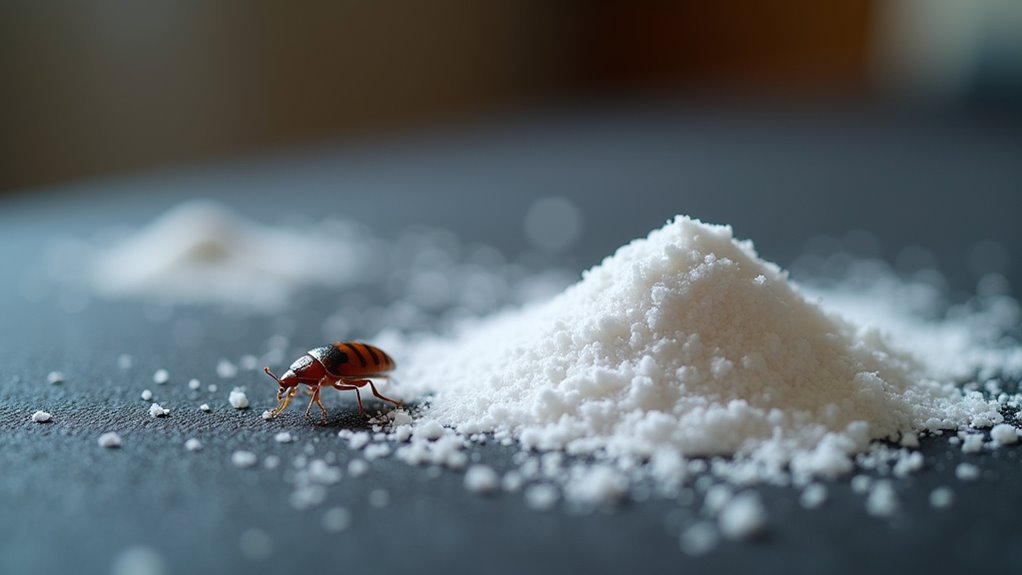
Although many homeowners turn to baking soda as a DIY bed bug remedy, this common household ingredient simply doesn’t possess the properties needed to eliminate these persistent pests.
The popular theory suggests baking soda causes dehydration by absorbing fluids from bed bugs’ outer shells, but scientific evidence doesn’t support this claim.
Bed bugs don’t ingest baking soda like other insects might with poison baits, so they can easily walk over it without harm.
When exposed to moisture, baking soda breaks down quickly, undermining any potential fluid-absorption capabilities. This breakdown makes it an ineffective method for controlling infestations.
Without proper scientific backing, you’re fundamentally wasting time while bed bugs continue reproducing and spreading throughout your home unimpeded.
How Bed Bugs Actually Respond to Baking Soda Applications
When you sprinkle baking soda around infested areas, bed bugs simply walk around the treated spots and relocate to untreated sections of your home.
You’ll likely experience a false sense of security as the visible activity decreases temporarily, but this doesn’t mean you’ve eliminated the problem.
The bed bug eggs remain completely unaffected by baking soda applications, ensuring the infestation will continue through new generations hatching in the coming weeks.
Bed Bugs Avoid Treatment
Despite claims that baking soda creates an effective barrier against bed bugs, these resilient pests demonstrate remarkable adaptability when encountering treated areas.
You’ll find that bed bugs can easily walk through baking soda without actually ingesting it, allowing them to avoid treatment entirely. Their natural survival instincts kick in when they detect treated zones, prompting them to relocate to untreated spots throughout your home.
This avoidance behavior means your infestation simply shifts to new areas rather than being eliminated. You’re fundamentally playing a losing game of hide-and-seek with these pests.
The baking soda doesn’t create an effective barrier—it just forces bed bugs to find alternative routes and hiding places, making your problem harder to track and solve.
False Security From Applications
While you scatter baking soda around your bedroom believing you’ve gained the upper hand, you’re actually witnessing a masterclass in pest resilience that creates dangerous complacency.
This false security becomes your worst enemy when dealing with a bed bug infestation. You’ll watch these resilient pests simply walk over the baking soda without any adverse effects, yet you might interpret their temporary reduced visibility as progress.
Meanwhile, the infestation continues expanding behind the scenes. Eggs remain completely unaffected, ensuring new generations emerge while you’re convinced your ineffective treatment is working.
This deceptive calm allows bed bugs to establish stronger footholds in your home, making eventual professional intervention more expensive and time-consuming than if you’d addressed the problem correctly initially.
Eggs Remain Completely Unaffected
Even if baking soda could somehow affect adult bed bugs, you’re facing a biological reality that renders this home remedy completely useless: the eggs remain absolutely untouched.
Baking soda doesn’t penetrate or damage bed bug eggs in any way, allowing the infestation cycle to continue uninterrupted. A single female can lay over 500 eggs in hard-to-reach crevices where your baking soda applications can’t reach.
When these untreated eggs hatch, they’ll rapidly repopulate your space, creating a resurgence that’s often worse than the original problem. Since bed bugs survive months without feeding, your eradication efforts face continuous waves of newly hatched bugs, making any temporary reduction in adult populations completely meaningless for long-term control.
Why Baking Soda’s Dehydration Theory Doesn’t Work in Practice
Although the theory suggests baking soda dehydrates bed bugs by absorbing moisture from their shells, this approach doesn’t hold up under real-world conditions. The dehydration concept lacks scientific evidence and proves ineffective against these resilient pests.
| Problem | Reality | Result |
|---|---|---|
| Moisture contact | Baking soda breaks down | Lost effectiveness |
| Shell penetration | Waxy layer blocks access | No dehydration occurs |
| Consumption method | Bed bugs don’t eat it | Bugs walk over safely |
You’re dealing with insects that don’t consume baking soda, making the dehydration theory meaningless. Their protective waxy shells prevent moisture absorption, while the powder’s breakdown upon contact with humidity eliminates any potential impact. This ineffective method won’t address bed bugs’ rapid reproduction rates.
The Problem With Bed Bug Eggs and Baking Soda Treatment
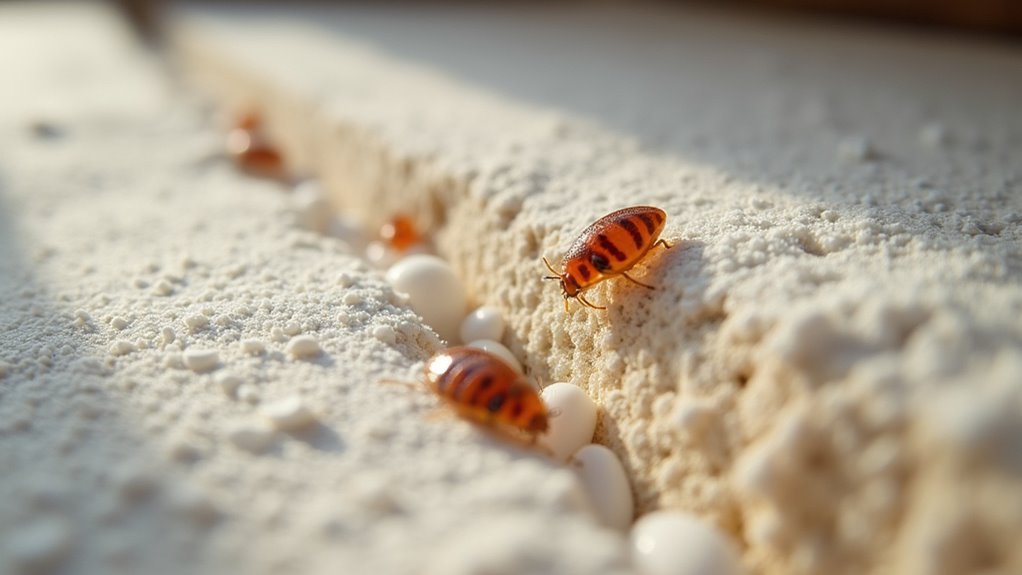
Even if baking soda could somehow kill adult bed bugs, you’re still facing a major problem with their eggs.
These eggs resist baking soda treatment entirely and remain hidden in cracks, crevices, and fabric seams where the powder can’t reach them effectively.
You’ll discover that these protected eggs continue hatching into new infestations, making your baking soda efforts fundamentally futile.
Eggs Resist Baking Soda
Most bed bug eggs remain completely unaffected by baking soda treatment, creating a significant obstacle in your fight against these persistent pests.
The waxy outer layer protecting bed bug eggs creates an impenetrable barrier that baking soda can’t breach. This protective coating guarantees the eggs stay viable regardless of your baking soda applications.
You’re facing a significant challenge since each female can lay over 500 eggs during her lifetime.
These eggs hide in crevices where baking soda can’t reach them effectively. The chemical properties of baking soda simply aren’t designed to disrupt bed bug reproduction cycles.
When your treatment proves ineffective against eggs, you’ll experience a false sense of security.
The infestation will resurge as new generations hatch, leaving you back where you started despite your efforts.
Hidden Egg Locations
Strategic hiding spots make bed bug eggs nearly impossible to reach with baking soda applications. You’ll find these eggs hidden when viewing mattress seams, furniture cracks, and spaces behind baseboards where your baking soda simply can’t penetrate.
These hard-to-reach locations provide perfect protection for developing eggs, keeping them safe from any treatment you might attempt.
The sticky substance surrounding each egg creates additional challenges. This natural adhesive bonds eggs firmly to surfaces in cramped spaces where baking soda particles can’t effectively settle or make contact.
Even if you manage to apply baking soda nearby, it won’t reach the actual eggs.
This inaccessibility directly contributes to recurring infestations. While you’re treating visible areas, hundreds of protected eggs continue developing in their secret locations, ensuring the cycle continues.
Rapid Egg Hatching
While you’re applying baking soda to visible areas, bed bug eggs continue their relentless development cycle in hidden locations. These eggs hatch within 6-10 days under ideal conditions, creating waves of new infestations that overwhelm any initial progress you’ve made.
| Timeline | Population Impact |
|---|---|
| Day 1-5 | Eggs remain protected in cracks |
| Day 6-10 | First wave hatches undetected |
| Day 12-20 | Second generation begins laying |
| Day 18-30 | Rapid population growth accelerates |
Even if baking soda manages to dehydrate bed bugs on contact, the untreated bed bug eggs guarantee your infestation rebounds stronger than before. A single female produces over 500 eggs during her lifetime, making any treatment that ignores eggs fundamentally flawed. You’ll need an effective treatment that targets all life stages simultaneously.
How Baking Soda Creates a False Sense of Security
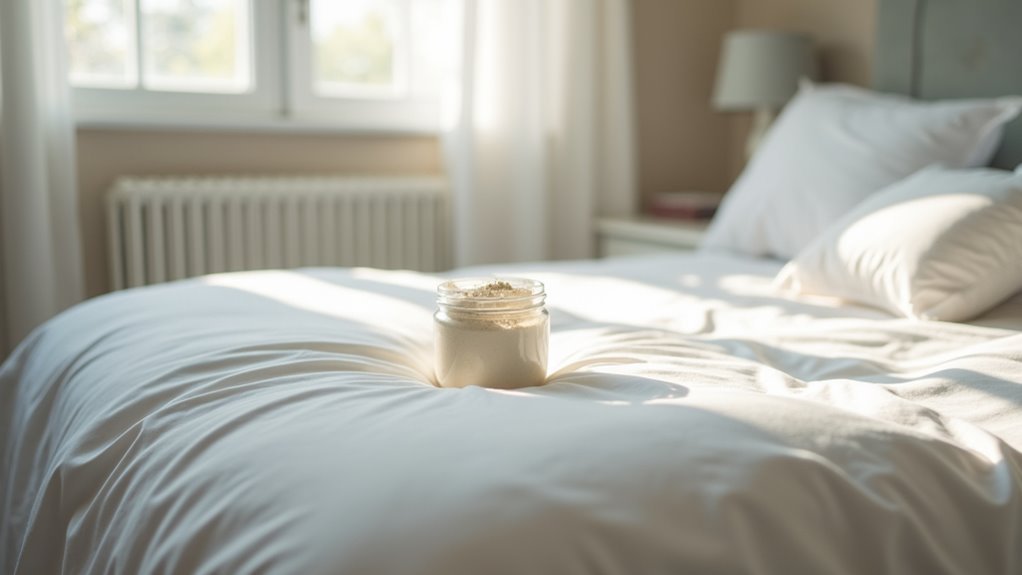
When you sprinkle baking soda around your bedroom and notice fewer visible bed bugs the next day, you might feel relieved that you’ve found an easy solution to your problem.
This apparent success creates a dangerous false sense of security that can worsen your infestation.
Baking soda isn’t effective at killing bed bugs or their eggs, despite what you might observe initially.
Baking soda creates the illusion of success while bed bugs simply relocate and continue multiplying in untreated areas.
The bugs simply avoid treated areas and relocate to other spots in your home.
Meanwhile, hidden populations continue reproducing undisturbed.
This misleading relief prevents you from taking proper action.
You’ll delay contacting professional pest control while believing you’ve solved the issue.
Unfortunately, this allows the infestation to spread and grow, making eventual elimination far more challenging and expensive.
Why Bed Bugs Simply Walk Through Baking Soda Barriers
Despite homeowners’ hopes that baking soda will create an effective barrier, bed bugs possess natural defenses that make this household remedy completely useless.
These pests have a waxy shell that acts like protective armor, preventing baking soda from adhering to their bodies or causing any harm. You’ll find that the small granules don’t disrupt their movement whatsoever – bed bugs simply walk right over them as if they’re not even there.
The barriers you’ve carefully placed around bed frames and furniture won’t stop these determined insects. Their waxy coating allows them to navigate through baking soda without absorbing it, making your efforts ineffective.
Unlike other pests that might be deterred by powder substances, bed bugs treat baking soda barriers as minor inconveniences they easily overcome.
The Rapid Reproduction Rate That Outpaces Baking Soda Effects
Even if baking soda could harm some bed bugs, you’re fighting a losing battle against their explosive reproduction rate.
A single female can produce over 500 eggs during her lifetime, with new generations emerging every 10-14 days under ideal conditions.
These resilient pests can survive over 300 days without feeding, meaning they’ll continue multiplying in hidden areas while your baking soda treatment fails to keep pace with their exponential growth.
Exponential Egg Production Speed
While you’re sprinkling baking soda around your bedroom, bed bugs are engaging in a reproductive marathon that’ll quickly overwhelm any dehydrating effects the powder might have.
A single female bed bug can produce over 500 bed bug eggs throughout her lifetime, creating rapid population growth that renders baking soda virtually useless against established infestations.
These eggs remain safely tucked away in mattress seams, furniture cracks, and wall crevices where your baking soda can’t reach them.
Even if dehydration eliminates some adult bugs, the hidden eggs continue developing undisturbed. Within six weeks, you’ll face fresh waves of hungry bed bugs emerging from their protected nurseries.
This exponential reproduction cycle means that while you’re hoping baking soda works, thousands of new bed bugs are preparing to invade your space.
Survival Without Feeding
Beyond their explosive breeding capabilities, bed bugs possess an extraordinary survival mechanism that makes baking soda treatments completely futile.
These resilient pests can survive without feeding for up to a year, rendering your dehydration attempts useless during extended dormant periods.
Here’s why survival without feeding destroys baking soda’s effectiveness:
- Extended dormancy periods – Bed bugs remain hidden and inactive while you’re applying treatments.
- Continuous reproduction cycles – They’ll reproduce rapidly once feeding resumes after treatment periods.
- Dehydration resistance – Their ability to conserve moisture naturally counters baking soda’s drying effects.
- Strategic hiding behavior – They retreat to untreated areas during starvation periods.
This extraordinary endurance means your infestation will persist despite consistent baking soda applications, as these pests simply outlast your treatment efforts.
Resistance to Intervention
Although bed bugs appear vulnerable to household remedies, their explosive reproductive rate creates an insurmountable challenge that renders baking soda treatments completely ineffective.
You’re facing insects where a single female produces over 500 eggs, creating exponential population growth that completely outpaces any minimal impact baking soda might have.
While you’re sprinkling powder around your home, these pests continue their relentless reproductive cycle, generating new infestations faster than the treatment can address existing ones.
Even if baking soda affects some adults, the eggs remain completely untouched, hatching into fresh generations that perpetuate the problem.
This rapid reproduction means you’ll never gain ground against bed bugs using such ineffective methods.
How Using Baking Soda Can Make Infestations Worse
When desperate homeowners turn to baking soda as their primary weapon against bed bugs, they often unknowingly sabotage their own efforts. This seemingly harmless remedy can actually transform a manageable bed bug infestation into a much larger problem through several mechanisms:
- False security delays action – You’ll underestimate the severity while bugs continue multiplying.
- Displacement spreads infestation – Bed bugs simply relocate to untreated areas, expanding their territory.
- Eggs remain unaffected – Baking soda doesn’t kill eggs, ensuring population growth continues.
- Missed treatment opportunities – You’ll waste precious time avoiding effective treatments.
Since bed bugs survive months without feeding, ineffective methods like baking soda prolong infestations considerably.
This delay prevents thorough pest control when it’s most needed, making eventual eradication exponentially more difficult and expensive.
Professional Heat Treatment Vs Baking Soda: a Comparison
The stark reality becomes clear when you compare professional heat treatment against baking soda’s lackluster performance.
Professional heat treatment delivers temperatures of at least 50°C for over 90 minutes, guaranteed to eliminate bed bugs at all life stages, including resilient eggs. You’ll get 100% effectiveness with specialized equipment that identifies cold spots, ensuring complete extermination throughout your home’s hidden cracks and crevices.
Professional heat treatment guarantees 100% bed bug elimination at all life stages with specialized equipment reaching every hidden corner.
Baking soda can’t penetrate these critical hiding spots where bed bugs thrive.
While heat reaches every corner systematically, baking soda only dehydrates a handful of surface bugs, leaving the majority untouched.
You’re fundamentally comparing a precision weapon against a kitchen ingredient.
Professional heat treatment eliminates entire infestations permanently, while baking soda creates dangerous false confidence that prolongs your suffering.
Proven Alternatives That Actually Kill Bed Bugs Effectively
Since baking soda fails to deliver meaningful results, you’ll need proven methods that actually eliminate bed bugs from your home.
Unlike ineffective home remedies, these scientifically-backed approaches guarantee success in killing bed bugs across all life stages.
Effective Bed Bug Elimination Methods:
- Professional heat treatment – Maintains 122°F for 90+ minutes, eliminating eggs and adults throughout your entire home.
- Professional pest control with detection dogs – Achieves 98% accuracy in locating infestations for targeted extermination.
- Steam treatment – Handheld steamers reaching 200°F kill bed bugs instantly on contact.
- Freezing protocol – Three days of freezing temperatures effectively destroys bed bugs in sensitive items.
For maximum effectiveness, combine these methods through integrated pest management.
This thorough approach guarantees complete elimination where baking soda consistently fails.
Frequently Asked Questions
Why Do Bed Bugs Hate Baking Soda?
You might think bed bugs hate baking soda, but they don’t. They’ll easily navigate around it, aren’t deterred by its texture, and won’t ingest it, making baking soda completely ineffective against them.
What Scent Kills Bed Bugs Instantly?
You won’t find any scent that kills bed bugs instantly. While rubbing alcohol’s strong odor accompanies its bug-killing properties, essential oils like lavender only repel them. You’ll need professional heat treatments or insecticides for effective elimination.
What Bugs Hate Baking Soda?
You’ll find that fleas, ants, silverfish, and cockroaches hate baking soda. It dehydrates fleas, damages cockroaches’ waxy shells, and creates an uncomfortable texture that ants and silverfish actively avoid walking through.
What Makes Bed Bugs Hard to Get Rid Of?
You’re dealing with resilient pests that reproduce rapidly, hide in tiny spaces, resist common insecticides, survive months without feeding, and often remain undetected until infestations become severe and widespread.
In Summary
You’ve seen why baking soda can’t solve your bed bug problem. It won’t dehydrate them, can’t penetrate their eggs, and gives you false hope while the infestation grows worse. Don’t waste time with this ineffective home remedy that’ll only delay proper treatment. You’ll need professional heat treatment or proven insecticides to actually eliminate these persistent pests. Stop experimenting with baking soda and take immediate action with methods that actually work.

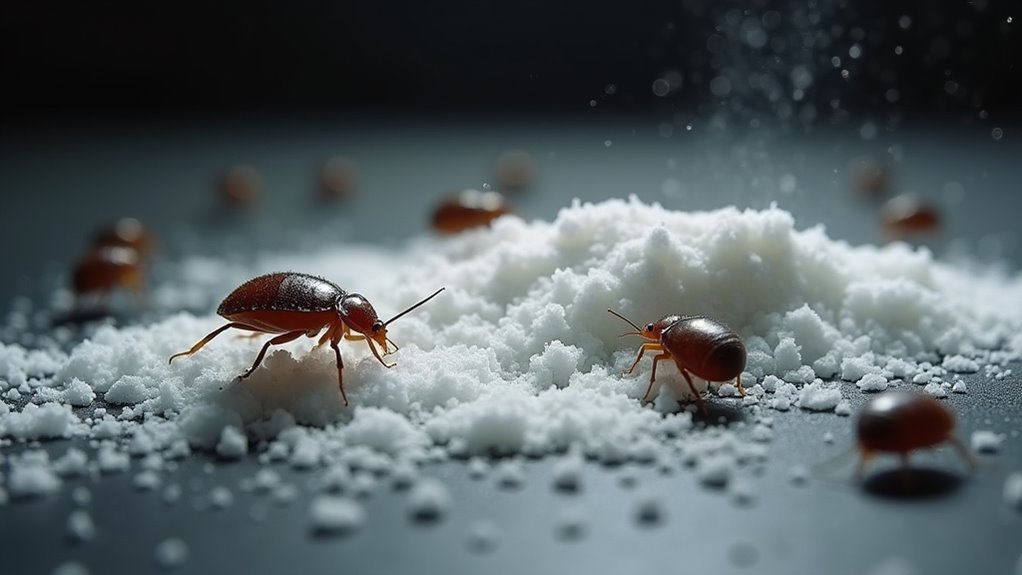
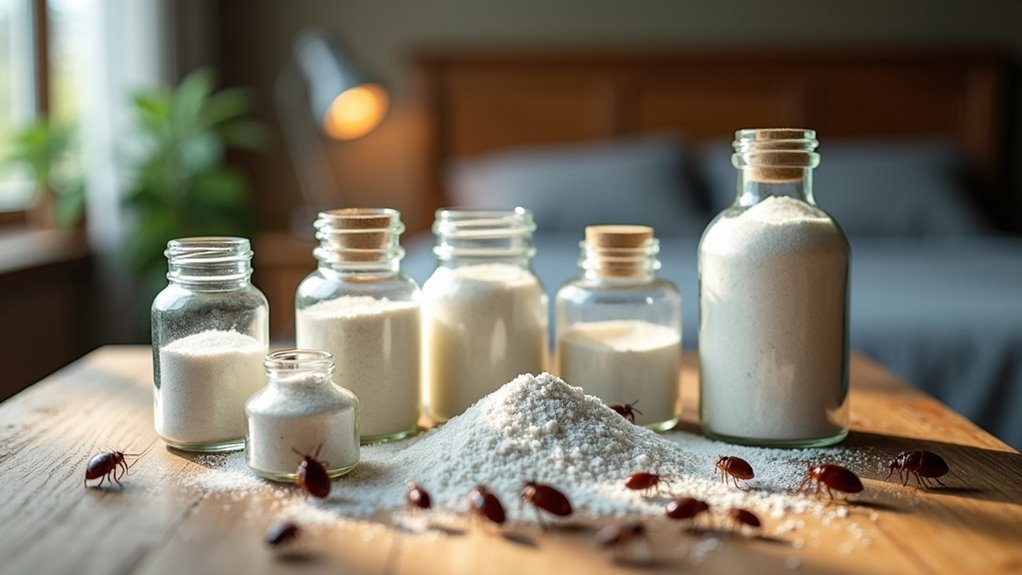
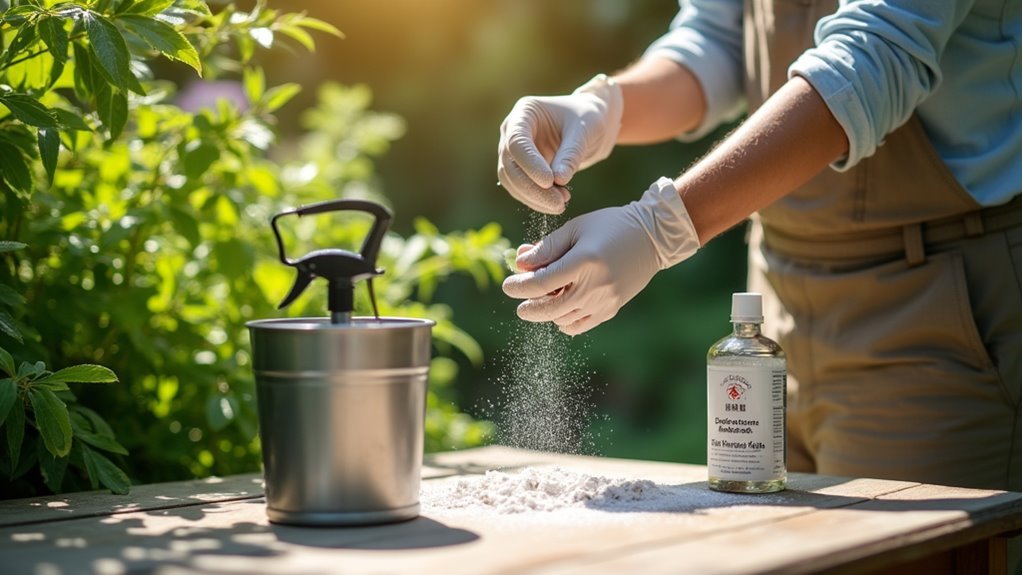

Leave a Reply